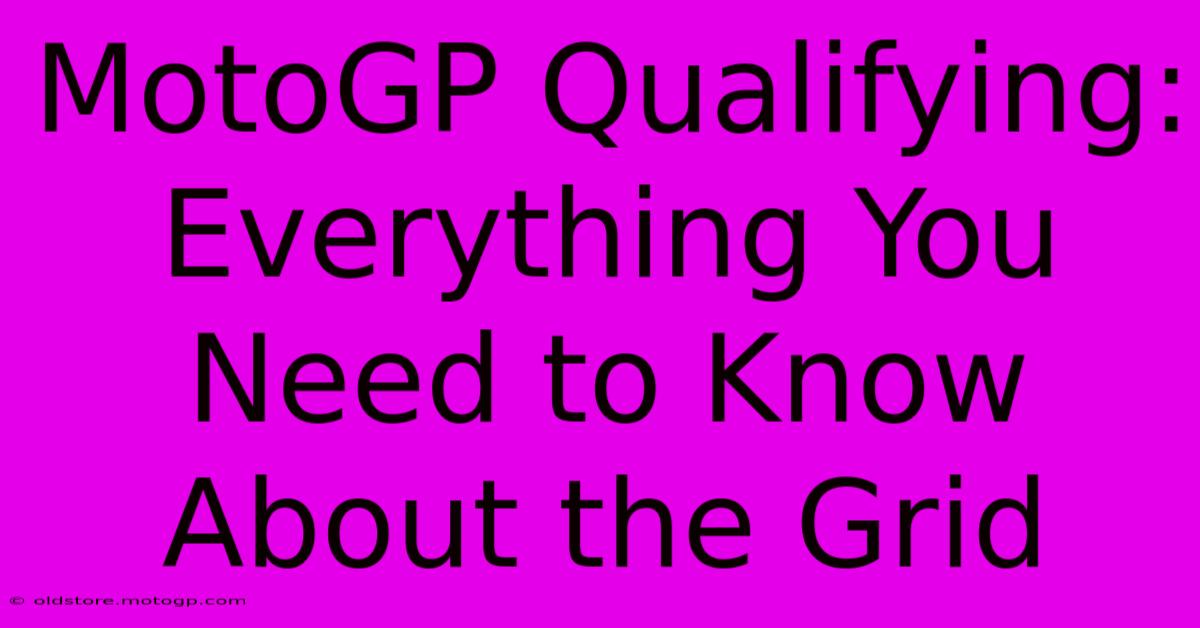MotoGP Qualifying: Everything You Need To Know About The Grid

Table of Contents
MotoGP Qualifying: Everything You Need to Know About the Grid
MotoGP qualifying is a crucial part of the race weekend, determining the starting positions for the Grand Prix. Understanding the intricacies of qualifying can significantly enhance your viewing experience and appreciation for the sport. This comprehensive guide will break down the process, explaining the different sessions and the strategies employed by riders and teams.
The Importance of Qualifying in MotoGP
The starting grid in MotoGP is incredibly important. A good starting position significantly increases a rider's chances of winning or achieving a podium finish. Getting a clean start, avoiding first-corner incidents, and gaining an early advantage are all directly influenced by the qualifying result. Even a slight improvement in grid position can make a huge difference in the final outcome of the race.
The Qualifying Format: A Step-by-Step Guide
MotoGP qualifying is a multi-stage process designed to create a thrilling and competitive environment. Here’s a breakdown:
1. Free Practice Sessions (FP1, FP2, FP3):
These sessions, held on Friday and Saturday morning, allow riders to test different setups, tires, and race lines. The data collected is vital in preparing for qualifying. While not directly part of qualifying, FP3 often dictates which riders progress directly to Q2.
2. Qualifying 1 (Q1):
The riders with the slowest combined times from the three Free Practice sessions participate in Q1. This is a 15-minute shootout, with only the top two riders progressing to Q2. The pressure is immense, with riders pushing their limits to secure a place in the next round. This often leads to some of the most exciting moments of the qualifying weekend.
3. Qualifying 2 (Q2):
The top 10 riders from FP3, along with the two fastest from Q1, compete in Q2. This is a 15-minute session to determine the all-important front row and the starting grid positions from 1st to 12th. This session sees the most intense battle for pole position, often involving incredibly close lap times and strategic maneuvering.
Strategies and Tactics in Qualifying
Teams and riders employ various strategies throughout the qualifying sessions:
- Tire Management: Choosing the right tires for each session is crucial. Using a softer compound might provide a faster lap time but risks degrading quickly.
- Slipstreaming: Riders will often "slipstream" or draft behind other bikes to gain a speed advantage on the straights, enabling them to achieve higher top speeds.
- Track Conditions: Understanding the track temperature, grip levels, and weather conditions is essential for setting the optimal lap time.
- Race Setup vs. Qualifying Setup: Finding the right balance between a bike set up for qualifying speed and one optimized for race pace is a constant challenge.
The Importance of Pole Position
Securing pole position – the fastest qualifying time – is a significant accomplishment. It provides a rider with a massive advantage going into the race. The rider starting from pole position has the opportunity to lead into the first corner and dictate the race. This psychological advantage can be as important as the strategic benefit.
Beyond the Grid: The Impact of Qualifying
The qualifying results don't just determine the starting grid. They also influence race strategy and team decisions. A poor qualifying result can force teams to adopt more aggressive race strategies, while a strong qualifying performance allows for more calculated and measured race plans.
Conclusion: Understanding the Grid
Understanding MotoGP qualifying is vital for fully appreciating the sport. The intense competition, strategic decisions, and high-stakes atmosphere make it a crucial part of every Grand Prix weekend. By understanding the different stages and the strategies employed, you can better follow the action and appreciate the skill and precision involved in securing a prime starting position on the grid. Pay close attention next time you watch – the battle for the grid is just as captivating as the race itself.

Thank you for visiting our website wich cover about MotoGP Qualifying: Everything You Need To Know About The Grid. We hope the information provided has been useful to you. Feel free to contact us if you have any questions or need further assistance. See you next time and dont miss to bookmark.
Featured Posts
-
The Epitome Of Speed Moto Gp Motorcycle Awaits
Feb 19, 2025
-
Hondas Moto Gp Tech A Closer Look
Feb 19, 2025
-
Moto Gp Top Speed A Glimpse Into The Future
Feb 19, 2025
-
Race Bikes For Sale Take Your Cycling To New Heights
Feb 19, 2025
-
Experience The Evolution Moto Gp Replica Helmets
Feb 19, 2025
